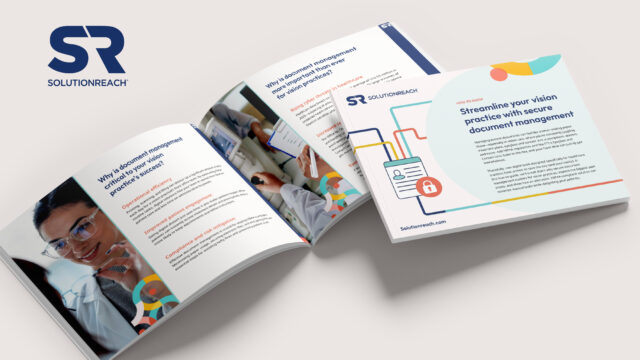Manually notifying patients when their eyewear arrives can feel like a never-ending carousel of phone calls, voicemails, and missed connections. In today’s fast-paced world, patients want quick, convenient updates—and your staff would rather spend time on patient care than playing phone tag. Below, we’ll explore why manual eyewear notifications are such a burden, how they impact your front office workflow, and how automation can offer a simple, game-changing solution.
Why is manually notifying patients about eyewear arrivals such a hassle?
Let’s face it: most of your patients aren’t sitting by the phone all day, waiting for your call. From busy work schedules to picking kids up from school, life gets in the way—and your staff ends up making repeated calls just to let someone know their glasses or contacts have arrived. Here are a few reasons why the manual approach can be such a headache:
Time-consuming calls
According to a Medical Group Management Association (MGMA) report, staff can spend up to 10 hours a week on phone calls for administrative tasks.
Voicemail limbo
Many calls go straight to voicemail. Patients might not hear or check messages promptly, so your team has to follow up again—and again.
Phone tag frustrations
When you do reach a patient, you may catch them at a bad time, forcing staff to juggle callbacks and coordinate messages later.
Over the course of a month, these extra steps quickly pile up, eating into hours your front office could spend assisting patients in person or helping the clinical team.
How does manual eyewear notification affect my front office workflow?
In a word: chaos. Every time your staff member stops to make an eyewear notification call, they’re pulled away from other critical tasks—like welcoming patients, scheduling appointments, or verifying insurance. That interruption takes a toll:
- Fragmented focus: Switching between phone calls and front desk duties disrupts workflow and increases the chance of errors.
- Backlog builds up: While staff are busy chasing down patients, front office tasks—like insurance checks, appointment reminders, and patient reception—can stall.
- Stress for everyone: Frequent interruptions and phone tag lead to stressed-out employees, which can affect morale and job satisfaction.
For an optometry or ophthalmology practice, every minute matters. It’s no secret that staff shortages are an ongoing concern in healthcare, so maximizing your team’s efficiency is vital.
What are the hidden costs of phone tag?
The cost of phone tag goes beyond stress and frustration. In many cases, it directly impacts the bottom line:
Potential delays in pickup
When patients don’t get the message, their eyewear might sit at the office longer. This can complicate inventory management or raise patient dissatisfaction if they find out late.
Slower turnaround
The more time staff members spend making repeated calls, the less time they have to handle new eyewear orders, potentially slowing down sales and revenue.
Patient perception
If a patient feels they’re not being communicated with efficiently, they might perceive the office as disorganized, affecting overall satisfaction and loyalty.
According to a Software Advice survey, 66% of patients prefer text-based communication from healthcare providers. If you’re not using a more convenient method, you risk frustrating a majority of your patient base.
Is there a better way to notify patients automatically about their eyeglasses and contact lenses?
Absolutely! With today’s technology, there’s no need to rely solely on manual phone calls. An automated patient communication tool can do the heavy lifting for you:
- Text or email notifications: Patients get instant updates when their eyewear arrives, with no staff intervention required.
- Two-way texting: Some platforms allow patients to text back with questions or confirmations, reducing phone calls even further.
- Centralized dashboard: Your team can see who’s been notified and who’s picked up their eyewear—no more sticky notes or phone logs.
This approach not only meets patients’ communication preferences but also cuts down drastically on repetitive tasks.
How does automation benefit my vision practice?
An automated eyewear notification system may sound like a dream come true, and that’s because it often is! Here’s how it can revolutionize your office:
Save time
By automating notifications, staff hours spent on the phone can decrease significantly. Studies show that text messages are read within 3 minutes of receipt, on average. This quick response time can eliminate round after round of missed calls.
Get staff off the phones
Instead of playing phone tag, your team can focus on delivering top-notch patient experiences, assisting doctors, and handling more complex questions that require a personal touch.
Improve patient experience
When patients receive automated updates, they feel more informed and in control, enhancing their overall satisfaction.
Allow staff to focus on patient care
Freeing up front-desk time means your staff can address in-person patient needs, maintain smooth check-ins, and support practitioners more effectively.
Automating eyewear notifications is a win-win: patients are happier, and your staff can use their time more efficiently, improving both revenue and retention.
Where do I go from here?
Implementing an automated notification tool doesn’t have to be complicated. Many patient communication platforms integrate seamlessly with your practice management software, making setup straightforward. When you’re evaluating options:
- Prioritize HIPAA compliance to ensure patient data remains secure.
- Look for robust features such as real-time notifications, two-way texting, and a user-friendly dashboard.
- Evaluate analytics and reporting tools that help you monitor notification success rates.
- Consolidate your tech stack by choosing an all-in-one patient communication platform that includes eyewear notifications, appointment reminders, recall alerts, and payment reminders—reducing monthly subscription costs while streamlining your workflow.
Once in place, you’ll wonder how you ever managed without automated eyewear alerts. It’s like moving from dial-up to broadband—once you’ve experienced the speed and convenience, you’ll never want to go back.

To learn more about other must-have vision practice technology that can save you team time and increase your revenue, download the guide “Streamline Your Vision Practice with Secure Document Management: A How-To Guide.”
Download Guide



